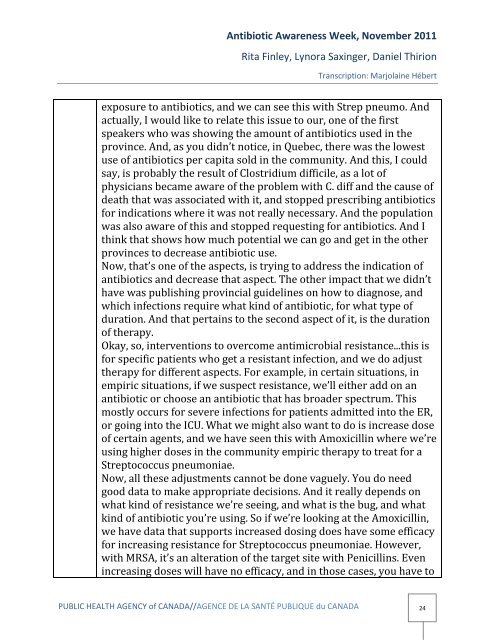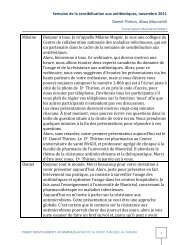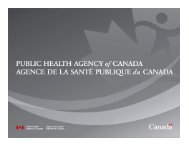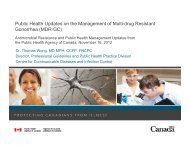read the transcript - Antibiotic Awareness
read the transcript - Antibiotic Awareness
read the transcript - Antibiotic Awareness
- No tags were found...
Create successful ePaper yourself
Turn your PDF publications into a flip-book with our unique Google optimized e-Paper software.
<strong>Antibiotic</strong> <strong>Awareness</strong> Week, November 2011Rita Finley, Lynora Saxinger, Daniel ThirionTranscription: Marjolaine Hébertexposure to antibiotics, and we can see this with Strep pneumo. Andactually, I would like to relate this issue to our, one of <strong>the</strong> firstspeakers who was showing <strong>the</strong> amount of antibiotics used in <strong>the</strong>province. And, as you didn’t notice, in Quebec, <strong>the</strong>re was <strong>the</strong> lowestuse of antibiotics per capita sold in <strong>the</strong> community. And this, I couldsay, is probably <strong>the</strong> result of Clostridium difficile, as a lot ofphysicians became aware of <strong>the</strong> problem with C. diff and <strong>the</strong> cause ofdeath that was associated with it, and stopped prescribing antibioticsfor indications where it was not really necessary. And <strong>the</strong> populationwas also aware of this and stopped requesting for antibiotics. And Ithink that shows how much potential we can go and get in <strong>the</strong> o<strong>the</strong>rprovinces to decrease antibiotic use.Now, that’s one of <strong>the</strong> aspects, is trying to address <strong>the</strong> indication ofantibiotics and decrease that aspect. The o<strong>the</strong>r impact that we didn’thave was publishing provincial guidelines on how to diagnose, andwhich infections require what kind of antibiotic, for what type ofduration. And that pertains to <strong>the</strong> second aspect of it, is <strong>the</strong> durationof <strong>the</strong>rapy.Okay, so, interventions to overcome antimicrobial resistance...this isfor specific patients who get a resistant infection, and we do adjust<strong>the</strong>rapy for different aspects. For example, in certain situations, inempiric situations, if we suspect resistance, we’ll ei<strong>the</strong>r add on anantibiotic or choose an antibiotic that has broader spectrum. Thismostly occurs for severe infections for patients admitted into <strong>the</strong> ER,or going into <strong>the</strong> ICU. What we might also want to do is increase doseof certain agents, and we have seen this with Amoxicillin where we’reusing higher doses in <strong>the</strong> community empiric <strong>the</strong>rapy to treat for aStreptococcus pneumoniae.Now, all <strong>the</strong>se adjustments cannot be done vaguely. You do needgood data to make appropriate decisions. And it really depends onwhat kind of resistance we’re seeing, and what is <strong>the</strong> bug, and whatkind of antibiotic you’re using. So if we’re looking at <strong>the</strong> Amoxicillin,we have data that supports increased dosing does have some efficacyfor increasing resistance for Streptococcus pneumoniae. However,with MRSA, it’s an alteration of <strong>the</strong> target site with Penicillins. Evenincreasing doses will have no efficacy, and in those cases, you have toPUBLIC HEALTH AGENCY of CANADA//AGENCE DE LA SANTÉ PUBLIQUE du CANADA 24






